How to Make Nvr Upload to Cloud Storage
May 18, 2016.

Deject storage has get increasing pop the last few years for storage solution needs that arise in companies. It has also become very popular equally a solution for off-site storage and fill-in of footage from IP cameras and IP camera systems that need lots of storage space, every bit recording in HD resolution is very retentivity intensive. Hd video uploads crave a high bandwidth and immense amounts of difficult drive infinite. As security photographic camera video quality keeps getting better with the advent of higher resolution CMOS image sensors, this only adds to the need for more storage space .
Deject storage provides convenience and an actress level of security by allowing off-site backup of your data. In the event of catastrophes similar fires or theft, your data will even so be accessible from anywhere with cloud storage. This is ane of the all-time ways of storing or backing up your sensitive and important information as the storage is offsite, stored on hard drives that are redundant, supported by companies with a lot of resources similar redundant power and fire extinguishing systems, and your data is accessible wherever and whenever you need it.
Using Quality Equipment
As always, proper equipment is fundamental to providing a professional service or running a business properly, in all walks of life. This is relevant to your retention storage solutions for many reasons. Using good quality IP cameras volition enable your recordings to be loftier definition, and information transfers to exist equally efficient and secure as possible. When your security and well-existence are what's at take chances, using professional form equipment will brand the difference when it matters. This is non simply for visual quality either, there is more to it than that.
Cheaper cameras or systems lack in several primal features that are necessary to enable deject storage, such as ftp upload capability. You want quality cameras and DVR or NVR recorders like these that enable you to configure recording both internally and remotely to either an FTP server or another NVR as backup.
These days deject based security cameras for the home consumer marketplace are also becoming popular, nevertheless the companies selling these types of cameras are more often than not selling cheaper equipment up forepart which happens to expect very pleasing thank you to clever designs. The monthly video storage fees for these cameras are likewise exorbitant, and brand them unrealistic for a security camera system consisting of multiple cameras. The visitor may offering a small corporeality of storage space as an introductory offering, and when you add more storage space or cameras, the monthly charges add upwards fast.
Options for Cloud Storage
If you have purchased a IP camera, NVR, or HD DVR photographic camera organization from u.s.a., and y'all decide cloud storage is something yous want to integrate into your security photographic camera system, there are several different options to consider. This article will go over iii price effective methods, two of which do non entail any monthly fee.
- Offsite NVR: You lot can stream video directly from your IP cameras over the net to an NVR located off-site for video storage. The NVR acts as the server in a deject (offsite). Alternatively, it is possible to take two NVRs where the primary NVR is on the same site as the cameras. The secondary NVR taps into video streams from the primary NVR for backup of video in real fourth dimension. You tin can even use a offsite NVR to tape video from non-ip based cameras by using our DVR recorders that can accept analog and HD over coax cameras, and make each camera's video stream accessible over the network.
- Personal FTP Server: Using free software similar FileZilla you lot can transform your PC or Mac into an FTP server that your IP cameras can upload video and/or snapshots to. Video tin can be uploaded continuously or when activated past movement.
- Paid Cloud Storage: Using a paid service to connect to your cameras or system and host your cloud storage. Recurring monthly charges apply to this choice.
Requirements to Go on in Heed When Using Cloud Storage
At that place are several details to go on in mind when configuring deject storage with your cameras. Showtime and perhaps the most crucial, y'all demand broadband internet service where the cameras are located. Your upload and download speeds must exist high in order to properly support the task of sending video and/or snapshots. The primary purpose of cloud storage is to send information straight to a computer or NVR at a location other than where the cameras are located. For many people incorporating deject-based recording ways constant video streams to be uploaded all the fourth dimension, making high-speed internet service crucial, and not something to be disregarded.
The upload speed required depends on the number of cameras that will exist recorded in the Deject simultaneously at whatsoever given fourth dimension and the camera resolution. For example, i-megapixel 720P IP cameras will require nigh 3Mbps (Megabits) of bandwidth per second while 2-megapixel 1080p IP cameras will require 4-6 Mbps per photographic camera. For everyday employ, nosotros suggest merely recording when move is detected; each camera can trigger a video feed to be uploaded for itself when it detects motion in the video using built-in analytics in the photographic camera. This mode, you don't necessarily accept all cameras uploading video at the same fourth dimension.
The technical knowledge base is great to have too. To be able to understand connectivity and networking and to be able to troubleshoot is invaluable when because deject storage. Fortunately, the setup is piece of cake enough that with a little enquiry, this task is not too complex for the average computer user.
Lastly, a fast PC with enough of storage is vital when choosing to build you own FTP server. Your internet service is one affair, but having powerful hardware is crucial to saving incoming video streams which tin be an intensive process. We recommend using at least an Intel i5 dual-cadre CPU based computer.
Offsite NVR
One of the easiest methods to accomplish cloud-based video storage of IP cameras or even DVR systems is past using an off-site NVR. By placing an NVR at a location other than the cameras constitutes recording in the cloud where the NVR is the server existence recorded to. Permit's say yous want to save video from your business organization, and you take broadband internet like Verizon FiOS at your home and business organisation. By simply utilizing these net connections you lot can make your NVR at home an "NVR in the cloud."
There are two ways to connect IP cameras to an offsite NVR:
ane. Primary offsite NVR: Cameras can stream directly to the network video recorder located outside the premises
ii. Secondary offsite NVR: Cameras stream beginning to an on-site NVR (primary NVR), and so an off-site NVR can connect to the primary NVR and fill-in video. This creates a redundant video storage system where there are two copies of the video. Should 1 unit of measurement fail the other NVR would have a copy and go on to record even in the outcome of hard drive failure on the other unit. This task is only possible with our NVR recorders. It is important to note that it is not necessary to record on both NVRs. You can choose to tape on whichever NVR yous choose, i.e. onsite or offsite.
Chief OffSite NVR - Direct Camera to OffSite NVR Streaming
This method involves a data stream to be established betwixt the photographic camera and the NVR in the cloud over the internet. The data stream for IP cameras can encompass video, sound, ptz data, and other metadata. Since this data stream must traverse the internet, it requires port forwarding rules to be provisioned on the router or firewall behind which the cameras are located. Otherwise, the NVR will be unable to connect to the cameras.
Our IP cameras have a dedicated video stream available via a TCP port which is set past default to 37777 on every camera. A port forwarding rule has to be provisioned on the router for each camera that you have. If yous accept multiple cameras, their TCP port needs to be unique since every network can only take one port-forwarding rule per external port. Get-go, you have to modify the TCP port of the second camera to 37779, and 37780 for the third and then on. Second, create rules in your router to open up up the firewall and route traffic for each port to the respective camera's IP address. You tin can observe more data near port forwarding hither along with router specific port forwarding guides here:
Once port forwarding is established, you lot tin can manually add each photographic camera equally a Remote Device through the NVR'due south menu. Enter the static external IP address of the location where the cameras are located in the IP address field and the TCP port number for each camera. Nosotros propose changing the default username and password for the cameras to ensure boosted security. One time you enter the proper username and password and hit connect, the NVR will connect to each photographic camera.
Secondary Off-Site NVR - On-Site NVR to Off-Site NVR Streaming
The chief difference between this method and the one above is that it doesn't crave many port forwarding rules to be set in the router where the cameras are located. Simply put, from a networking standpoint, this is an like shooting fish in a barrel to follow setup. This secondary method of cloud video storage likewise has the added do good of redundant video storage on-site and off-site. We recommend this solution over the first for many reasons, especially in the event of net failure yous will still take footage saved on the on-site NVR. For businesses storage redundancy is an important factor to consider.
So how does information technology work? It'south very simple and doesn't require much technical expertise. Using a uncomplicated point and click operation you tin configure both NVRs.
Outset, physically install your PoE cameras and use one of our NVR'due south with built-in PoE to make the process easier. Having a built-in PoE switch on the NVR allows the NVR to automatically assign each photographic camera a different IP address and makes the process of installing cameras on the network a non-technical chore that anyone can do. Using the Remote Device carte du jour option, search for the cameras and choose the cameras you want the NVR to connect. In one case added to the NVR these cameras will automatically be configured for streaming and recording on the NVR. Delight apply our guide on adding IP cameras to a PoE NVR for more than information.
One time y'all have an IP camera system with NVR working at the primary location, connect information technology to the main router on the bounds. Configure 1 port forwarding rule on your router to open up port 37777 and point it towards the internal IP address of the NVR. The default IP address of the NVR is 192.168.ane.108. If you have a network with a 192.168.ane.x subnet, you should be able to ping the NVR at the in a higher place IP. You can use GRC Scan to ensure that your port forwarding rule is working and port 37777 is open.
Second, place the secondary off-site NVR which volition serve equally storage in the cloud in another location where you have internet. Using the Remote Device menu option, manually add cameras from the primary NVR by filling out information equally follows:
- Aqueduct: This is the camera number on the secondary NVR and it will automatically increment as you add together cameas in ascending lodge.
- Manufacturer: Leave as Private if you lot are using equipment purchased from CCTV CAmer World
- Accost: xxx.xxx.30.30 – Enter your external IP address for the network at the principal location. You can discover what it is by going to a computer at the main location and typing www.myipaddress.com from a spider web broswer.
- Port: 37777 – This is the video streaming port. In this configuration type where yous are connecting to one NVR to leech multiple camera streams, this port will stay the same considering the NVR will allow y'all to select different channels to stream from a single port
- User / Countersign: Enter the vi character username and countersign configured for a user on the Primary NVR
- Remote Channel: Enter the camera or channel number from the Master NVR that you would like to stream.
- Decoder Buffer: get out at 280ms
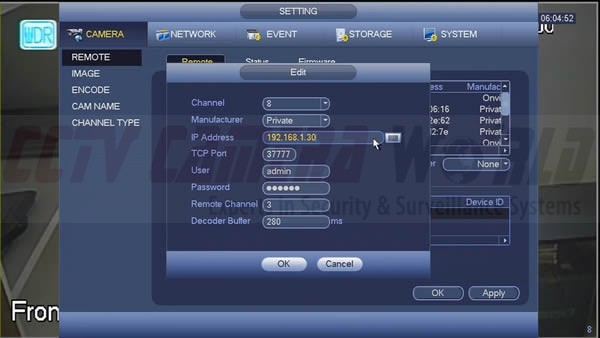
You should now have all the cameras from the main NVR streaming to your "Deject NVR." You can configure any recording schedule and encoding resolution independent of the primary NVR. You tin can even tape in less resolution to save difficult drive storage space and prolong video recording. For boosted information on setting recording schedules, delight come across these articles:
- How to setup a recording schedule on your NVR or DVR
- Motion Detection Recording Setup for Security Camera DVRs
Personal FTP Server: Recording without a NVR
There is another free option to consider for users that have more computer and networking technical knowledge. That option existence file transfer using FTP through programs such as FileZilla. By installing FileZilla on a Windows or Mac calculator, you are able to receive information, similar recordings or images from cameras over the local network or over an internet connection. This enables yous to have access to these files from anywhere, eliminating the demand to be on site for playback or file downloading purposes. Uploading video or images from your IP cameras via FTP is an economical solution for primary video storage without needing an NVR.
For this task, you will need your IP cameras, a gratuitous FTP program such equally FileZilla and some knowledge of networking. With the stride past step tutorial beneath, you lot should be able to configure your cloud storage setup with minimal endeavor, regardless of your technical proficiency level.
Beginning, we will brand a destination binder to save all our snapshots and videos to. Create a new folder on your computer's hard drive and telephone call it something like "FileZillaFolder." We propose using a secondary difficult drive in your computer to proceed camera recordings separate from the rest of your files.
Install FileZilla
Adjacent download the FileZilla server program to follow along. At the installation screen, y'all volition see a screen asking which port number y'all want FileZilla to operate on. The default should exist 14147, leave it as is.
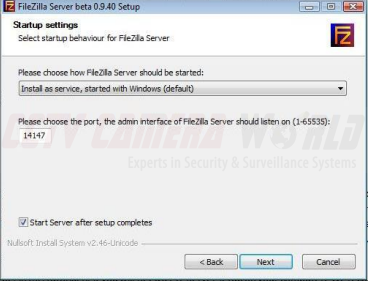
In one case it is finished installing a prompt volition appear called "Connect to server" with several options for the setup. Y'all tin choose your server address, for our purpose we used a loopback address of "[: : 1]" to salve directly to our computer. Also, there are options for the port number information technology should operate on. This should be the port number that it was dedicated to at the installation screen (14147). Create your own administrative password and click OK.
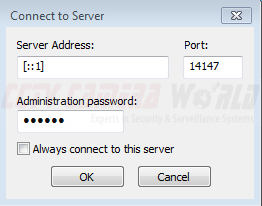
Create a User Group
Later on y'all click OK, the FileZilla server will get-go and yous will meet the master window for the server application called the 'Filezilla Server Interface." Make sure you are using the Filezilla Server Interface from this point forward. From here you desire to make a new group and user to control administrative rights. Click "Edit" in the pinnacle menu of the programme window, and then select the choice "Groups".
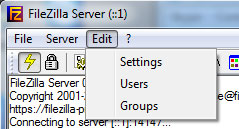
On the right, there is a push button for "add". Click add to bring up the "Add together user group" window (see pic below) and proper name your group. For this tutorial purpose, nosotros name information technology "business". Click OK to save.
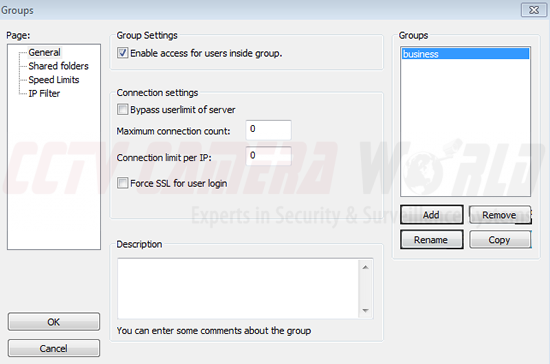
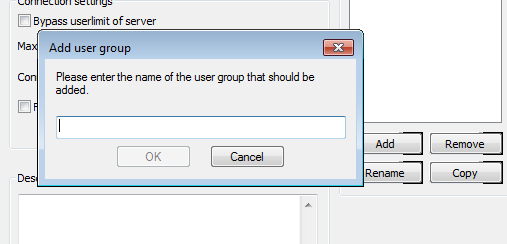
Create a New User and Assign to Group
From here we become back to Edit in the peak menu of the program window, and this time, select "Users."

Now on the left under "page" at that place will exist an option for "shared folders." Create a new user and select a home directory all at once. Both are important steps for configuration. Under users there will be a button for Add. Click this to add a new user.
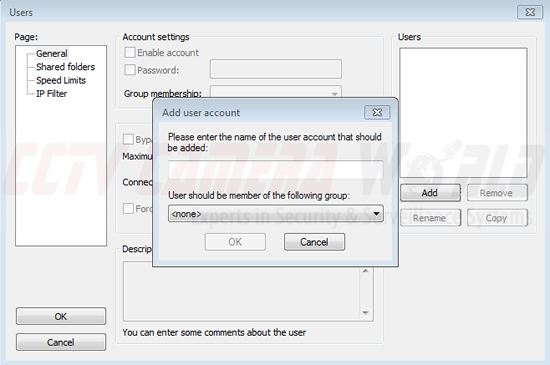
Choose a name for this user. And so in the drop downward menu, at that place will exist the option to cull the group. Cull the group nosotros only fabricated and add this new user to it. Nosotros named our user "ipcam" and assigned it a password of "ipcam" to continue it simple. Click OK to finalize settings.
Assign Shared Folder to User
Now in the aforementioned window, we will need to configure a shared folder directory to save our videos and snapshots to. Under "shared folders" there will exist a button for "add." Click this to open the carte du jour, and find the binder named "FileZillaFolder" you made earlier to save your pictures and videos.
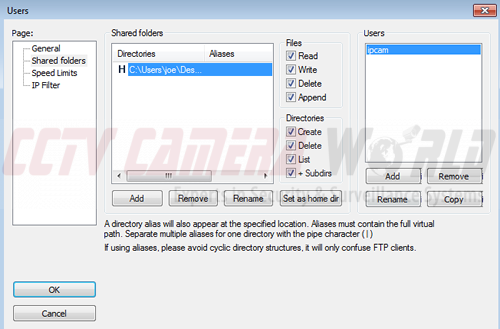
This will automatically make this the abode directory for the FTP user we but created. Now when yous run into it under the "directories" header, click information technology to select it as shown above. Now you lot will see the files and directories permissions on the side that show what yous are allowing this user to do. Yous MUST brand sure that all boxes nether "Files" and "Directories" are checked to let your FTP user read/write access to the directory. Click OK to apply settings and from here nosotros tin can motility on to the residue of the configuration which will be done on the IP camera.
Now that we have our server configured we need to get into our IP camera and change the settings to permit for FTP transfer to our FileZilla estimator. First, we will need to determine what our computer's IP address is. The easiest way to do this is to bring upwardly the command prompt.
Find your Computer'due south IP Address
Go to the windows icon in the bottom left of your computer screen. In the search bar, type "CMD" and click on the application to bring up your command line.
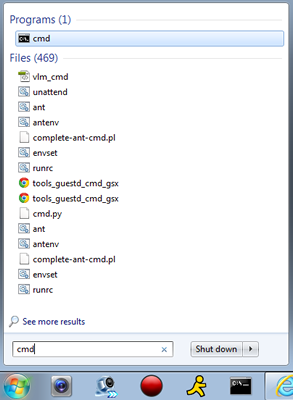
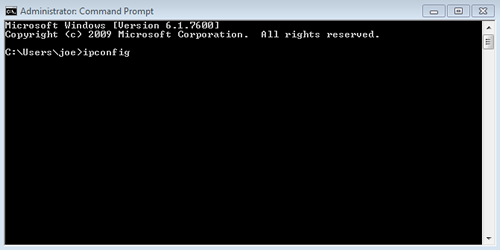
From here you lot need to blazon in the command "ipconfig" to get your network information. Click enter to run the command.

Here you volition meet a response that says "ipv4" with an IP address such as 192.168.1.4 This is our computer's IP accost.
Write down your IP accost and you can then close the command prompt.
Configure FTP recording on your IP camera
Go to your internet browser and blazon in your IP Camera'south IP address. This volition access the IP camera interface as long as it is connected to the network.
Here type in your IP camera's login data to admission the settings. It'due south commonly admin/admin if yous oasis't changed it to something else. One time yous access the IP photographic camera, there will exist a tab at the superlative of the chosen "setup."
![]()
Clicking this will bring upward settings options. With setup selected there will exist more tabs on the left side to bring upward further menus. Click "storage" to bring upwardly the drop-downward menu and and so click "destination" to bring up the configuration page we need.
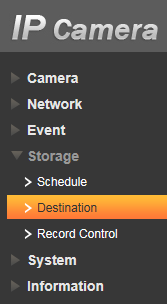
The first tab on this menu is "Path." Here you volition come across an option called "FTP" with boxes next to it. Nether the "Record" and "Snapshot" sections, make certain all three boxes for FTP are selected. Exist sure to save your settings.

Next, go to the "FTP" tab at the elevation to bring upwardly the next bill of fare.
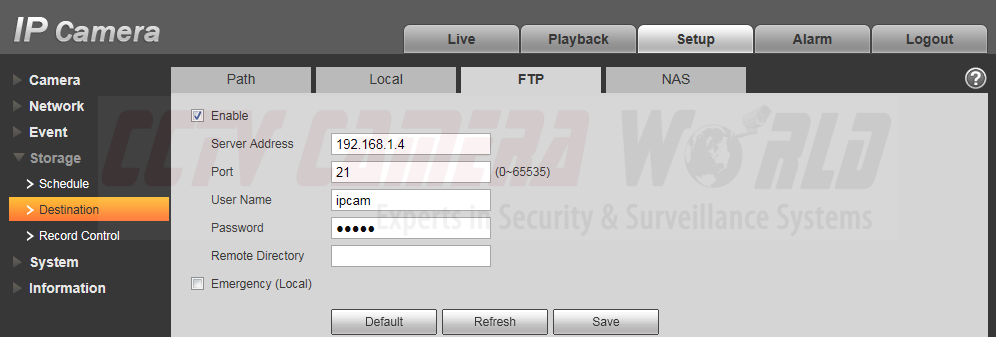
At that place will exist a checkbox for "enable." Make sure this is checked, otherwise, this volition not work!
The "server address" volition be your estimator's IP address interim every bit the FileZilla Server. In our case we have entered our internal IP accost. If y'all are sending files to a server on the internet, you can certainly enter it here.
Next, the "port" should be 21 which is for FTP protocols. "User name" should exist the user you lot created above in FileZilla. We named ours "ipcam." Fill in the countersign and get out "remote directory" blank otherwise it will brand a new folder within the destination binder and things will get messy. Save your settings every bit e'er and yous are finished with the IP camera settings.
Finished
From here, you should be all prepare and yous should come across that your camera'southward file activity as lines of text in the FileZilla server window. All data (videos and snapshots) is uploaded by the camera to the folder y'all created using the FTP protocol.
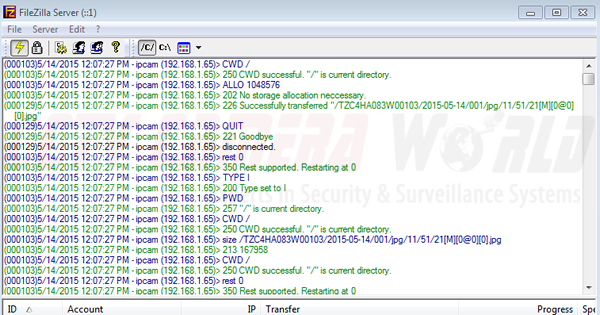
This article shows you how to save price and host a FTP server on your own computer. Y'all can use the steps outlined for camera configuration in a higher place and target the camera to a FTP server located on the cyberspace. Yous can apply a hosting provider like Godaddy to purchase a FTP server, and upload video footage from your cameras or NVR to it.
Troubleshooting
It is worth noting at this point that if you exercise not come across activity in your server screen, you might have to disable the firewall on your computer to permit for incoming FTP transfers.
The videos are saved in DAV format. To play these types of videos, we recommend the DAV Histrion that comes on the CD included with your camera purchase.
Choose a recording in your folder and right click to bring up the menu. From hither click "open with…" to choose the thespian y'all want to view the recording with. Ready it to the DAV Player y'all installed. At present you lot should exist able to view your recordings.
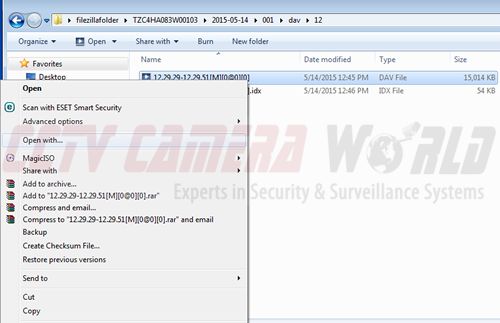
Your FTP computer should be all set upwards and ready to become from hither. You lot can configure FTP credentials for the same user in multiple cameras. Each camera volition upload video and/or snapshots and relieve them in a different folder proper noun according to the camera'south serial number.
The camera folder inside the destination binder volition be named using the camera'due south serial number by default.
Paid Cloud Storage Services
The last pick to keep in mind is implementing a paid cloud storage service. This is an option more geared towards large businesses and users that demand a lot of storage capacity. The boilerplate user would probably discover this option too much of a hassle for them when they look at the pricing and realize there are other options available. In fairness, there are some benefits as well as restraints.
With many cloud storage hosting services, oft times y'all must utilize their cameras and products with the service. Many take cameras and software specifically designed and supported with their service. Often times you do not even outright own the cameras, you are renting them through the company. You are at the will of the service provider, and this is something that is only non acceptable for users that are security and privacy minded.
The cameras and software are often subpar equipment. The cameras are ordinarily cheaper form cameras with little back up base behind them. Simple models that are actually only suitable for indoor home use are normally standard, and well-nigh often they are lacking several key features that consumers look for when doing inquiry. Some examples being high-quality night vision IR technology, varifocal lens cameras, outdoor waterproof/vandal proof features, adjustable and vandal resistant mounting.
Another event that many users don't consider until they have already made their buy is that these paid services cameras are ofttimes times incompatible with other services and NVR units. After already installing and using these cameras for a period of time they realize that if they decided to pursue other options for storage, the cameras will have to exist replaced, and then they observe themselves again locked into using the service.
For most cloud storage providers, y'all normally accept to pay monthly for their service. This monthly fee could be for a divers amount of storage, but more often than not it refers to how many cameras you lot are using. Amount per month per camera means that if you have a decent sized arrangement you will pay a hefty service charge every month just to record your cameras.
The costs tin can rapidly skyrocket for using subscription storage based cameras. If anything, it pays to do your research. You lot will notice that despite manufacturer advertisements of Hd quality video on these cameras, the video quality recorded in the finish depends on the speed of your cyberspace connection. If you are using DSL or cable modems, your upload speeds are limited and you will never come close to always obtaining Real Time 30fps Hard disk drive quality video recordings from these cameras.
Many businesses that need a big corporeality of storage might find this solution advisable for their requirements. Some services will offer unlimited cloud storage and back up for their service. This will help larger businesses that need to be up and running 24/7 and can't beget whatsoever downtime. If your business has a lot of sensitive information or videos that cannot exist leaked, this may not exist the best choice. While the information is your property, it is not exactly nether your command when y'all send it to a cloud storage service.
There are many options for cloud storage that are economical and feasible for every type of user. If monthly recurring cost cloud storage cameras are non for you, then nosotros recommend IP cameras or NVRs with FTP upload functionality paired with a FTP server for the cost-effective solution.
Source: https://www.cctvcameraworld.com/recording-security-cameras-to-ftp-cloud/
0 Response to "How to Make Nvr Upload to Cloud Storage"
Mag-post ng isang Komento